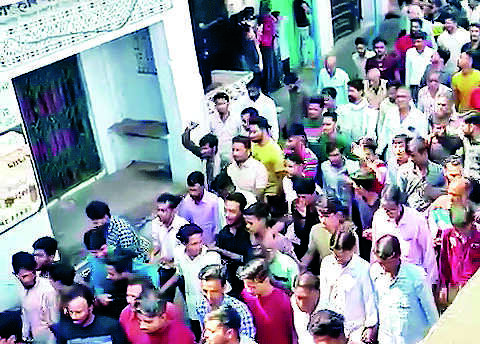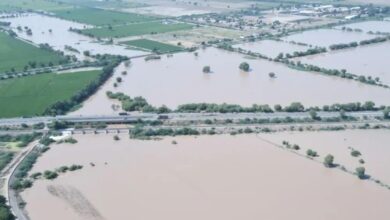Rajasthan
Once A Major British Admin Hub, Sambhar Renews District Demand | Jaipur News
Jaipur: The people of Sambhar in the present Jaipur district have renewed their longstanding demand to have the place converted into a separate district.
They are unhappy about the plans for 19 new districts that CM Ashok Gehlot announced recently, as per which Sambhar would be a part of the new district of Dudu.
Agitations are now intensifying in Sambhar tehsil, which centred around a revenue town during the Mughal period and remained a major administrative centre during the British rule. Since the catchment area of Sambhar Salt Lake, India’s largest saline lake and is the source of most of Rajasthan’s salt production, is almost thrice the size of Sambhar tehsil and spread in three districts—Nagaur, Jaipur and Ajmer—the locals want those areas to be parts of a united Sambhar district instead of Dudu.
Known for its snow-white salt surface, migratory birds, British-era bridges, railway line and pilgrimage centres for both Hindus and Muslims, Sambhar is longs to be made a separate district to sharpen its identity, and the residents are up in arms with this demand.
“The Gehlot government has betrayed the peace-loving people of Sambhar. Despite our memorandums and letters explaining why we need a united Sambhar as per our history and geography, our demand was ignored. We have decided to carry our agitations till our demand is met,” said Vivek Sharma, president of Sanyukt Morcha for Sambhar District (SMSD).
Calming that demand for a separate Sambhar district is 56 years old, Sharma said the oldest document attesting this fact is from 1967, a memorandum addressed to then CM Mohan Lal Sukhadia. “That document reads that United Sambhar includes Dudu, Phulera, Naraina, Renewal, Jobner, Nawa, Roopangarh and Fagi. This is an old demand, and it will end just with an announcement by the government,” added Sharma, an actor who has played side roles in three films, including Bollywood flick ‘Jodha Akbar’ starring Hrithik Roshan.
“Sambhar Salt Lake’s deteriorating state is because of the catchment areas lying in three different districts. Illegal mining and boring, divided revenues and enforcement would stop only when a united Sambhar district,” said SMSD coordinator Shambhu Lal.
The district court in Sambhar, railway line and the salt factory date back to the British era. Sharing documents from the 12th century to the late 19th century, Mahendra Khadgawat, the director of Rajasthan State Archives in Bikaner, said Sambhar had a glorious position for a long time due to its salt production. “A farman (legal document) from 1670 AD, the era of Mughal Emperor Aurangzeb, talks about a revision in the tax on salt production, indicating the importance of Sambhar. As per various historical accounts, Britishers had a commissioner in Sambhar for tax collection,” said Khadgawat.
They are unhappy about the plans for 19 new districts that CM Ashok Gehlot announced recently, as per which Sambhar would be a part of the new district of Dudu.
Agitations are now intensifying in Sambhar tehsil, which centred around a revenue town during the Mughal period and remained a major administrative centre during the British rule. Since the catchment area of Sambhar Salt Lake, India’s largest saline lake and is the source of most of Rajasthan’s salt production, is almost thrice the size of Sambhar tehsil and spread in three districts—Nagaur, Jaipur and Ajmer—the locals want those areas to be parts of a united Sambhar district instead of Dudu.
Known for its snow-white salt surface, migratory birds, British-era bridges, railway line and pilgrimage centres for both Hindus and Muslims, Sambhar is longs to be made a separate district to sharpen its identity, and the residents are up in arms with this demand.
“The Gehlot government has betrayed the peace-loving people of Sambhar. Despite our memorandums and letters explaining why we need a united Sambhar as per our history and geography, our demand was ignored. We have decided to carry our agitations till our demand is met,” said Vivek Sharma, president of Sanyukt Morcha for Sambhar District (SMSD).
Calming that demand for a separate Sambhar district is 56 years old, Sharma said the oldest document attesting this fact is from 1967, a memorandum addressed to then CM Mohan Lal Sukhadia. “That document reads that United Sambhar includes Dudu, Phulera, Naraina, Renewal, Jobner, Nawa, Roopangarh and Fagi. This is an old demand, and it will end just with an announcement by the government,” added Sharma, an actor who has played side roles in three films, including Bollywood flick ‘Jodha Akbar’ starring Hrithik Roshan.
“Sambhar Salt Lake’s deteriorating state is because of the catchment areas lying in three different districts. Illegal mining and boring, divided revenues and enforcement would stop only when a united Sambhar district,” said SMSD coordinator Shambhu Lal.
The district court in Sambhar, railway line and the salt factory date back to the British era. Sharing documents from the 12th century to the late 19th century, Mahendra Khadgawat, the director of Rajasthan State Archives in Bikaner, said Sambhar had a glorious position for a long time due to its salt production. “A farman (legal document) from 1670 AD, the era of Mughal Emperor Aurangzeb, talks about a revision in the tax on salt production, indicating the importance of Sambhar. As per various historical accounts, Britishers had a commissioner in Sambhar for tax collection,” said Khadgawat.





